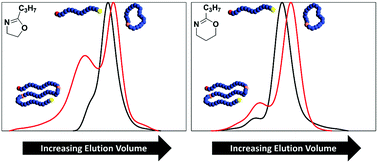The unique material properties of cyclic polymers have made them attractive biomaterials, prompting the need for more efficient cyclization protocols. Due to their chemical versatility, poly(2-alkyl-2-oxazoline)s (PAOx) and poly(2-oxazine)s (POzi) provide potent candidates in this field. However, little to no comprehensive data on the cyclization process of these materials is available, especially not for POzi. In this study, we investigate the impact of a number of reaction parameters (batch volume, catalyst equivalents, molecular weight, and polymer addition method) on the macrocyclization efficiency of PAOx and POzi using copper(I)-catalysed azide–alkyne cycloaddition (CuAAC). It was found that POzi show more efficient conversion to the desired monocyclic species compared to PAOx, possibly due to increased chain flexibility of POzi. Considering macrocyclization efficiency, up to 33× more cyclic POzi could be synthesized per unit volume of solvent, compared to previous protocols for related PAOx, indicating potential for the future scale-up of macrocyclic POzi.
